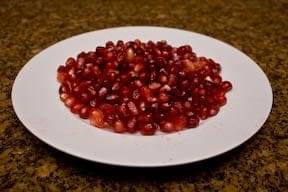Punica granatum
Pomegranate has an ancient reputation to uphold. This plump, scarlet fruit is filled with exactly 840 tiny seeds individually encased in sweet-tart juicy sacs called arils. (Go ahead and count them for yourself.) The fruit is technically a berry as the single flower produces a cluster of seed drupes. The unusual nature of Pomegranate has attracted the attention of poets and storytellers for centuries.
The tree originally came from Persia and has been a part of Middle Eastern food and culture since Babylonian times. The first mention of pomegranate’s introduction to a new environment is usually through myth and legend. Both Ganesh and Persephone use Pomegranate prominently in their stories. The sensuous red juice, fertile shape and no-nonsense taste has commanded attention since ancient times.
Medicinal Properties of Pomegranate
Pomegranate is a Middle Eastern favorite. The bark of the tree is noted as a powerful medicine for expelling tapeworms. The rind is made into a gargle. The pith is used a s a skin wash. The seeds are ground into a cooking spice. Of course, the best part of Pomegranate is the fruit. Pomegranate is a a delicious autumn fruit that adds color to any table and is packed with nutrition.
As the scientific community learns more about the role of antioxidants in the body, pomegranate’s nutrient rich juice is exploding onto supermarket shelves. Antioxidants are powerful free radical scavengers. Free radicals are responsible for cellular damage that show up as wrinkles or sneak around in the body via DNA damage. Patients recovering from surgery, athletes with torn tissue, and aging adults trying to add a few more years to their lifespans are advised to add more antioxidants to their diet.
New evidence has been confirmed by researchers from the City of Hope Beckman Research and Treatment Center in Duarte, California, who found that an acid found in pomegranates blocks one of the enzymes that promote the growth of breast cancer. Director of the Division of Tumor Cell Biology Dr Shiuan Chen stated that his team discovered ten compounds in pomegranate that have proved promising in the quest for breast cancer treatment. The enzyme in question is called aromatase. This chemical changes androgen into estrogen in the body. Cancer researchers have found success in treating some types of breast cancer with estrogen inhibitors.

One of the ironies surrounding pomegranate’s mythic symbol for fertility is its actual use as a contraceptive. This plant has been in steady use as a natural form of birth control since the Egyptian Dynasty and its use spread throughout Europe and the East during the Roman Empire. Pomegranate has a significant amount of phytoestrogenic compounds called estrone that are being currently researched as an effective birth control chemical with fewer side effects than “The Pill.”
Conditions Best Helped by Pomegranate

The antioxidant properties of pomegranate have a multitude of use. Heart patients are advised to consume the juice regularly. Prostate cancer patients are finding remission is accelerated by pomegrante as well. Free radicals that increase the detrimental effects of aging are reduced by regular glasses of pomegranate juice. Oily or damaged skin is refreshed by an astringent, antioxidant wash of diluted pomegranate juice.
The bark of the pomegranate tree and stem of the fruit contain between 22-28% of the alkaloid pelletierine. It is used, particularly in the Middle East, to purge intestinal worms (mostly notably tapeworms) which are prevalent in warm climates. This is a water soluble alkaloid that is taken in teas but is also available in alcohol based infusions.
For more information on the conditions best helped by Pomegranate, see the topics in Conditions.
List of Pomegranate’s Medicinal Actions
Astringent, antibacterial, nutrative, antioxidant, vermafuge and demulcent (seeds).
Medicinal Processing for Pomegranate
Pomegranate rind may be dried after eating the seeds and stored in a labelled bottle (away from light to preserve the antioxidants) for making an astringent gargle for sore throats. The rind is soaked in hot water until the water is lukewarm. Remove the rind and gargle.
The pomegranate white, which is attached to the arils, is an ancient Indian treatment for colds. Save the white after peeling the fruit and nibble it or save it dried for tea.
Pomegranate juice may be made at home but is cheaper to buy bottled in areas where the trees do not grow readily. Add one part juice to 3 parts water for an antibacterial mouth rinse a few minutes before brushing the teeth.
For more information on basic herbal preparations, see the topics in Herbal How-to.
Gardening and Gathering Pomegranate

If you’re looking for high fruit production, plan to spend some time pruning regularly during the first few years of growth. Likewise, if you’re aiming for the single or multiple tree trunk form, plan to prune regularly through out the tree’s life. Pomegranates grow lots of suckers from their roots and crowns.
Commercial pomegranate growers generally choose the single- and multiple-trunk forms for pomegranate growth, although the free-form shrub form is reputed to be highly fruit-producing as well.
Pomegranates are somewhat drought tolerant, although while the tree is establishing itself plan to water regularly. They prefer dry climates and are vulnerable to fungus, making growing them in a damp climate challenging. They can grow in places where the winter temperature gets down as low as 10 to 18 degrees Fahrenheit, but in those regions they’re unlikely to fruit or fruit heavily. Pomegranate’s philosophy is “the warmer, the better.”
Regardless of the form they take, pomegranates are prone to dropping much to all of their fruit in their first years of production. Pomegranates generally begin to fruit in their third to fourth year and by about year six are fully mature. Once they’re fully mature, they are unlikely to develop severe fruit drop and often will produce an abundance of fruit until year fifteen to twenty.
Pomegranate makes an excellent bonsai, too, due to the beauty and size of its flowers, the twisted appearance of its bark once it’s aged, and the strength of its wood.
quick ID tips
Appearance: Pomegranate fruit has a thick, deep red pericarp with juicy purplish red arils. The seeds are individually encased in the berry capsules.Pomegranate leaves are long, pointed, green, glossy, and leathery.Pomegranate’s bark is brown and smooth, although as it ages it becomes rough and twisted.Left to grow naturally, pomegranate is shrubby with many thin branches reaching for the sun. The flowers are orange to red, many petaled, and nestled along the older or mature branches amidst sprays of green leaves.
Taste: Sweet and tart juice with an astringent effect on the palate.
Odor: Tangy, sweet scent
Gathering Pomegranates
If you’re planning to harvest your own pomegranates, bring pruning shears along. Their fruits grown on tough stems that form on mature wood, so it’s better to snip rather than tug the fruits free of their stems. Be sure to pick your pomegranates just before they’re fully ripe so they don’t crack on the branch. Pomegranate season in the northern hemisphere is generally from September to January; in the southern hemisphere it’s March to May.
Pomegranates store well so long as they’re kept in a cool, dry place. Cold storage of up to five or six months can make their flavor richer while it makes their skin thinner and tougher. On the counter, they’re likely to store well for about a month and in the refrigerator for about two months. Fruit that is harvested unbruised will store much better than damaged fruit.
In colder climates, pomegranates start appearing in the groceries in mid- to late-fall through early winter. When selecting a pomegranate, look for fruit that’s firm and heavy for its size. The rind should be free of cuts and major blemishes, although as the season progresses the skin may appear more tough, wrinkled, and possibly slightly blemished.
Recipes, Household Formulas and Non-medicinal Uses of Pomegranate

Pomegranate seeds and skins can be used for dying. The seeds and arails produce a red dye, the skins and membranes yellow.
For more recipes and ideas for using Pomegranate, see the topics in Recipes.
Cautions for Pomegranate
No known cautions exist for pomegranate juice or rind but the bark should be used only under the advise of a qualified health specialist. Pomegranate is not advised as a birth control substitute without the advise of a qualified health specialist.
For more information see our History, Folklore, Myth and Magic page on Pomegranate.







